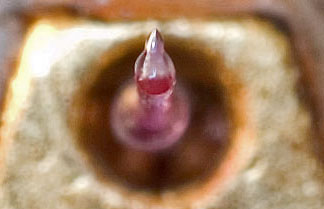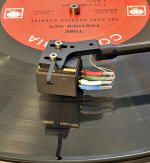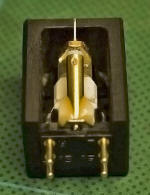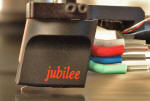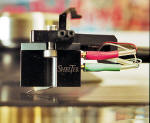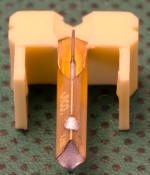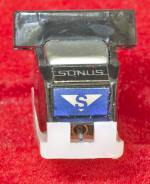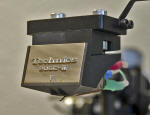-edible zone-
The Cartridge Gallery
notes plus various detail images of phono cartridges, and headshells....
________________________horizontal rule
ADC Audio Dynamics - a Peter Pritchard
company which, in 1974, he sold to BSR which continued to market and mfr his
designs. Two examples of which are just below.
A list of
compliance ratings and stylus configurations on different ADC XLM
models:
- ADC XLM compliance: 65 x 10-6cm/Dyne (1972), tip; Diasa elliptical
- ADC Super XLM compliance: 50 x 10-6cm/Dyne, tip; Shibata, (1972)
- ADC XLM mkII compliance: 30 x 10-6cm/Dyne 1975, tip; Diasa elliptical
- ADC Super XLM mkII compliance: 40 x 10-6cm/Dyne, tip; (1975)
- ADC XLM improved mkII compliance: 30 x 10-6cm/Dyne 1975, tip; Diasa elliptical
- ADC ST XLM II compliance: 30 x 10-6cm/Dyne 1975, tip; Diasa elliptical
ADC ST
Series: (Cartridge comes packaged with and mounted to (or in the case of
the ST XLM-1, integrated into) a carbon fiber headshell that plugs into
the ADC LMF-2 tonearm.
ST XLM-1:



The ST XLM-1 series is integrated into its adjustable overhang
headshell. The cartridge can not be separated from this headshell - and
- said headshell is specific to the ADC LMF-2 tonearm.
Thanks
to Alaskahiatt for these ST XLM-1 photos.
________________________________________horizontal rule
ST XLM-II
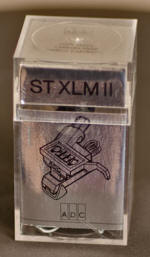

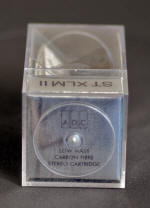
Btw,
with this model - ST XLM-II cartridges are simply removed from the packaged
headshell. The fasteners are 1/2" spaced and can be used in
several different tonearms of the appropriate low
effective mass design. (cartridge compliance is 30 x 10-6cm/Dyne,
tonearm should be low mass )
example:
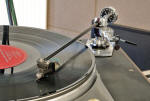 (click thumbnail for full size image)
(click thumbnail for full size image)
The ADC ST XLM-II mounted
to the Infinity Black Widow tonearm. (3 grams effective mass)
STXLM-II manual-1Rs.jpg (581951 bytes)
STXLM-II manual-2Rs.jpg (831424
bytes)
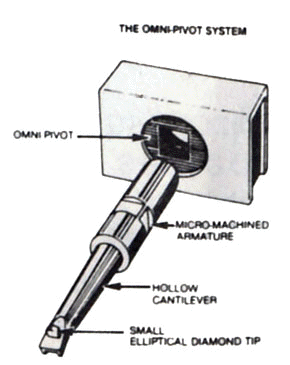
More detailed photos:
- DSC4684-Rs.jpg
- DSC4694-Rs.jpg
- DSC4695-Rs.jpg
- DSC4696-Rs.jpg
- DSC4697-Rs.jpg
- DSC4698-Rs.jpg
- DSC4701-Rs.jpg
- DSC4702-Rs.jpg
- DSC4707-Rs.jpg
- DSC4709-Rs.jpg
Note: Paired with the Infinity Black Widow tonearm - Review: (Link)
________________________________________horizontal rule
Warning: Denon DL-103R construction
zone...
 (click thumbnail for full size image)
(click thumbnail for full size image)
Above: an unmolested Denon DL-103R moving coil phono cartridge mounted in an RB250 tonearm. It was found that this arm-cart-combo worked and sounded better with a headweight. (link to article)
See what happens when idiots - such as yours truly - become unleashed and then physically molest these popular-to-modify moving coil phonograph cartridges.




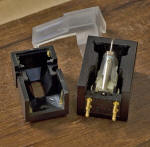 (click thumbnail for full size image)
(click thumbnail for full size image)
Above 3 photos: Henry's DL-103 ready to move into one of Uwe's ebony bodies....and then it's in.
Link to the build-article for more detailed info.
Below: My own Uwe ebony bodied DL-103R at work - with head
weight - in a Graham 2.2. The combo worked well.
Review pending. Or, at least, I owe a review on this model. I've spent enought time listening to 4 or five of these. Anyway, here is a serious hitter for those who would care to put it in one of Uwe's wood bodies, then match it up with the appropriate step up transformer. It likes a fairly heavy tonearm. And then there are options regarding cantilever and stylus....!
Design dates to 1962. Initially intended
for broadcast use. Still in production. Several variations were made
over the years. Currently the two versions still being offered are the
DL-103 and the DL-103R. The difference is in the copper coils. The "R"
uses a higher purity copper, called "6-nines copper" (99.9999% pure) and
has a different load impedance. The 103 and 103R share same family sound
but offer slightly different tonal character and with the "-R" offering
slightly improved upper frequency detail along with a smoother overall
tone quality.
output voltage: .2 mV Load: 14 ohms (DL-103R) and
40 ohms (DL-103) both require voltage step-up (Footnote)
 (click thumbnail to view image full size)
(click thumbnail to view image full size)
Above: Denon DL-103R in one of Uwe's Panzerholtz bodies. Also installed by Soundsmith is one of their ruby cantilevered line-contact stylii. Playing an Lp on the SP10 mkII. Tonearm is the Graham 2.2. This was a happy combination.

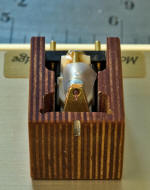
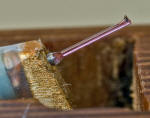

_____________________________________________horizontal rule
EMT TSD 15
 emt tsd 15 with modifications by UWE.
emt tsd 15 with modifications by UWE.
 action shot. Tonearm is the Schroeder CB
action shot. Tonearm is the Schroeder CB
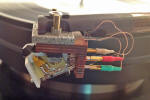 mod revisions with smaller value
capacitors, Panzerholz frame, Black Diamond and a big improvement in
sound.
mod revisions with smaller value
capacitors, Panzerholz frame, Black Diamond and a big improvement in
sound.
_____________________________________________________________horizontal rule
Grado Black
DSC3563-Rs.jpg (click link to view full size image)
DSC3564-Rs.jpg
Grado's least costly option - well
populated throughout the country - not quite
respectable and still available.
- Design: Moving Iron.
- Output Voltage: 5 mV,
- load: 47Kohms, does not require step-up
___________________________________________________horizontal
rule
Ortofon MC Jubilee

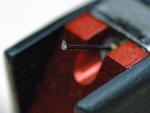 attempted close-up detail of the Shibata stylus.
attempted close-up detail of the Shibata stylus.
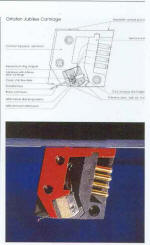 (click thumbnail for full size image)
(click thumbnail for full size image)
circa 2006, Review: (Link)
Specifications:
- Output voltage .34mv
- Freq. Range 20 - 60,000 hz
- Freq. Response 20 - 20,000 hz
- Compliance 16 um/mN
- Stylus type Nude Shibata
- Stylus tip radius r/R 6/50um
- Cantilever Solid boron rod
- Coil material 6-nines pure silver
- Magnet type Neodymium
- Tracking force range 2.0 - 2.5 grams
- Tracking angle 20 degrees
- Internal impedance, 5 Ohm
- Recommended load > 10 Ohms
- Cartridge body material Stainless Steel/aluminum
- Cartridge weight 10.5 gram
______________________________________________________________________horizontal rule
Pickering
UV-15 / D 2000-Q

- DSC3287-Rs.jpg (click link to view full size photo)
- DSC3286-Rs.jpg
- DSC3284-Rs.jpg
- DSC3293-Rs.jpg
- DSC3294-Rs.jpg
- DSC3295-Rs.jpg
- DSC3296-Rs.jpg
Specifications:
- Stylus part no. D2000 Q
- Stylus Description: Quadrahedral
- Tracking Force (1): 1 -3 grams
- Color: Black and White D-2000 Q
- Frequency Response (2): 20 to 45000 Hz
- Output (3): 3.8mv
- Channel Separation: 30 db
- Inductance Each Channel: 350 mh
- Resistance Each Channel: 750 ohms
- Accessory Stylus for Lp Records: Stylus No. 4510
- Accessory Stylus for 78 rpm
Records: Stylus No. 4527
Notes:
Recommended by Mfr for
optimum performance.
When the cartridge is terminated in the
recommended load of 100K ohms and 100 PF
Ouput with reference to 5.5
cm/sec record velocity.
Next three photos: microscope shots
 Left:
at 100x -- front view of the Quadrahedral stylus.
Left:
at 100x -- front view of the Quadrahedral stylus.
DSC1299-Rs.jpg At 200x
DSC1248-Rs.jpg
At 200x - Evidence of
light wear on the stylus.
Further notes: This cartridge appears to have some life left in
the stylus. However, and regardless of which tonearm it's mounted
in, it will not track the groove. Presume suspension failure --
either deteriorated elastomer or other fault which I have yet to
identify. That said, I am intrigued by the uniqueness of this
model and would like to experience it's sound qualities -- if it were
possible to recondition the suspension.
_____________________________________________________horizontal rule
Shelter 501- Type II
- output voltage: 0.4mV,
- stylus: elliptical,
- tracking force: 1.4g to 1.8g,
- DCR: 12 ohm, step up trans: within 10 ohms,
- head amp: within 100 ohm,
- frequency response: 20hz to 20khz +- 2db,
Shelter's notes on the cantilever: "Cantilever is not
covered by 1 year warranty. Please do not break it." Adjustment:
"SHELTER recommends to change stylus pressure within recommended
tracking force (1.4g to 1.8g) in summer and winter. in summer: .1g to
.2g less, in winter .1g to .2g more"
My notes: This cartridge has character. Dynamic. Expressive.
Emotional. Nice midrange. Bass is a little tight but extended and
detailed. Nimble. Fast transients. Not a particularly great tracker.
Review
here - (Link)
______________________________________________horizontal rule
Shure V15VxMR
This version of the V15 was made in Mexico. Now it is out
of production. It's the last of the V15 series. It is a nice sounding
moving magnet cartridge, if a touch rolled off in the high frequencies.
Capacitance of your tonearm wires need to be around 250 pF. Load =
47kohms. Static compliance is approx. 20 x 10-6nm. Compliance of this
model is not as soft as earlier V15 versions. I used it at first on the
TP16 tonearm (16.5g eff mass) with satisfactory if not optimal results. It mated well with my SME
3009 S2 and then the S2 improved tonearms, also the Rega RB250
tonearm; - Not so well with the Graham 2.2. - Fairly well with the
Infinity Black Widow tonearm. A touch laid back in its presentation.
-Not my favorite Shure but still very good.
Output voltage: 3 mV
does not require step-up
* (click thumbnail for full size image)
(click thumbnail for full size image)
Above: The Shure mounted to a Graham 2.2 tonearm
- DSC5952-Rs.jpg (136201 bytes)
- DSC_5968.jpg (182435 bytes)
- DSC_5969.jpg (289000 bytes)
- DSC_5970.jpg (293234 bytes)
- DSC_5971.jpg (214865 bytes)
- DSC_5972.jpg (249984 bytes)
- DSC_5973.jpg (253103 bytes)
_____________________________horizontal rule
Shure M91-E
From the early 1970's, here is the Shure M91-E First version. With the clip. Often under-rated, but just as often said to compare well with the top of the line V15 series from the same period. I'm presently using this sample in an Infinity Black Widow tonearm with excellent results. The original stylus assembly on this sample is long gone. It came to me with a new Pfanstiehl #761 elliptical stylus / aluminum cantilever assembly. A bit later I purchased from LP Tunes a Jico SAS stylus assembly. The Jico has the alu/boron cantilever with their SAS stylus profile. It is a replacement for the N91 Shure assembly. I like it.
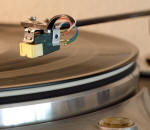 (click thumbnail for full size image)
(click thumbnail for full size image)
Above: BW tonearm with the Shure M91E / Jico SAS
Thus
equipped, in the BW arm, situated on the Thorens TD124, it has the Shure
family sound with very good detail both micro and macro. Very good low
bass extension which is neither loose nor tight. And weighty where it is
supposed to be. Mid-bass seems to be voiced for a touch of emphasis.
Right where I like it, actually. Midrange and treble seem natural to my
ear with no sense of emphasis or the lack thereof. Higher frequencies
are also very good.
_________________________horizontal rule
Sonic
Research Inc., Danbury Conn.
Sonus Blue
a Peter Pritchard Design
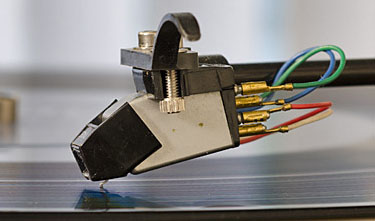
Above photo: Sonus Blue in the Infinity Black Widow Tonearm. A happy combo.
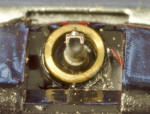 (click thumbnail for full size image)
(click thumbnail for full size image)
- DSC0804-Rs.jpg (click link for full size image)
- DSC0805-Rs.jpg
- DSC0807-Rs.jpg
- DSC0808-Rs.jpg
- DSC0815-Rs.jpg
- DSC0819-Rs.jpg
- DSC0802-Rs.jpg
Sonus Blue specifications from user manual:
- Voltage Output 4.0 mV @ 5cm/sec
- Compliance: 50cms/dyne x 10-6
- Vertical Tracking Angle: 20° nominal
- Channel balance ± 1dB
- Recommended load: 47k ohms
- Total Cartridge weight: 5.5 grams
- Tracking Force range: 1 to 1-1/2 grams
- Stylus Tip Form: Pathimax----(similar to Shibata but more conical at intersecting ground faces)
Review: (Link)
___________________________________________________________________horizontal rule
Sumiko Blue Point
Special

Modeled in Rhino
3D circa 2003. Rendered in Rhino.
High Output Moving Coil. Load=
47Kohms. Works with standard MM phono stages common to most 60's,70's
and 80's good quality stereo receivers.
In the late 1990's this
cartridge received rave reviews within the audio press. Based on these
recommendations I purchased the above sample. In practice I found that
the cartridge was a good compliance match to the Thorens TP16 (mk 1)
tonearm on my TD160. I also noticed that there was absolutely nothing
remarkable about the sonic performance of this cartridge. Average
sounding. Pretty good. Can't complain. Not great. ...since the first iteration,
Sumiko has worked to improve this model. The Blue Point Special Evo
would be one example of this. I haven't tried this one, however there
are some positive reviews to be read of the BPS Evo.
________________________________________________horizontal
rule
Technics EPC205C mkII

Cartridge
specs:
Type: Moving Magnet
- Output Voltage: 3.5 mV
- Frequency Response: 10Hz - 40 kHz
- Tracking Force: 1.0 - 1.5g
- Mass: 6.5g
- Channel Separation: 25 db
- Load Impedance: 47k ohms
- Stylus: EPS-205ED
- Stylus Tip: elliptical 0.2 x 0.7mil
- Cantilever: titanium
- Dynamic Compliance: 10 x 10-6cm/Dyne (@100Hz Works out to a10hz compliance value of ~20
- FYI: 10 x 10-6 cm/dyne is the same as 10-um/mN.
(click thumbnails for full size imagery)
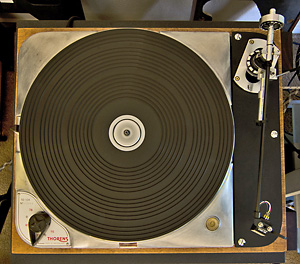 Mounted
to the Infinity Black Widow tonearm/Thorens TD124 turntable.
Mounted
to the Infinity Black Widow tonearm/Thorens TD124 turntable.

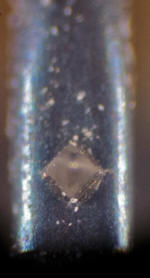


Above 3 photos: microscope shots.
I have a review of this
cartridge from 2017 mounted in the Black Widow tonearm.
Review: (Link)
_______________________________________________________________horizontal rule
Orsonic AV-101S, anti-vibration universal head shell
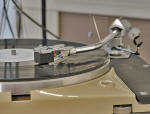 (click thumbnail for full size image)
(click thumbnail for full size image)
Above: The Orsonic in use with an SME 3009 S2 / rebodied Denon
DL-103R
Made in Japan.
- DSC5842-Rs.jpg
- DSC5843-Rs.jpg
- DSC5844-Rs.jpg
- DSC5845-Rs.jpg
- DSC5846-Rs.jpg
- DSC5847-Rs.jpg
-
DSC5848-Rs.jpg
_______________________________________________horizontal rule
Notes on cartridge
compliance rating systems:
The Dynamic rating:
There is at
least one thing the Technics EPC 205C-II and a Denon DL-103R *have in
common. Their rated compliance value is achieved through the same kind
of test procedure where: dynamic compliance @100hz is measured by
determining the minimum VTF at which the onset of mistracking occurs
when playing a 50um amplitude 100Hz frequency modulated groove. We can
find reference to this explanation from noted tonearm manufacturer H.H.
Moerch at his website where he has published a downloadable pdf we can
refer to.
Here’s a link to that document:
http://www.moerch.dk
then go to: homepage/instructions/cartridge armtube combination list)
In his paper, Moerch offers a simple means to translate from the
dynamic @100Hz value to the more common 10Hz rating that many/most
cartridges use. Simply take the rated "dynamic" value and multiply by
anywhere from 1.5 to 2. The Technics rated dynamic compliance of 10 *
10^6 cm/dyne, multiply by 2 = 20 at the 10Hz method. And this is a value
that can be plugged into a formula offered within the same Moerch paper
where the said formula can be used to predict the tonearm/cartridge
system resonance. Here it is:
- Where:
- C = cartridge compliance in either ( __* um/mN or __ * 10^6 cm/dyne) (the same)
- Ma = tonearm effective mass in grams
- Mcar = cartridge weight in grams (add also the weight of fastener screws and nuts, etc)
- Fress = system resonance frequency in Hz
Using the above
formula and plugging in the required values from the Black Widow spec
list I came up with a predicted arm/cartridge resonance at 10.9hz. This
proved to be close to reality. When using the HFN-001 test record, side
2 track 2** the measured resonance was 11Hz. The formula appears to work
and so did H.H. Moerch’s simple method of conversion (times 2) noted
above.
The Static compliance rating system: to be added
The 10Hz compliance rating system: to be added
footnotes on compliance rating systems:
*and many other
phono cartridges. When the compliance rating says "dynamic" we presume
this is what they mean.
** HFN-001 side 2 track 2 is the band
that tests for arm/cartridge system resonance -- lateral.
General Footnotes:
Generally, low output moving coil
cartridges are favored by many. Yet the disadvantage is that the
output voltage is so low it requires a step-up device in line between
itself and the phono-preamplifier. Another critical factor is the
introduction of noise and hum into this very fragile and vulnerable
signal. Great care must be taken to transform and deliver the signal
cleanly into the phono-preamplifier.
